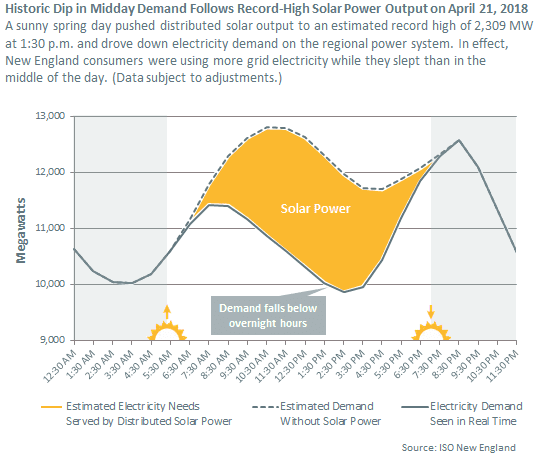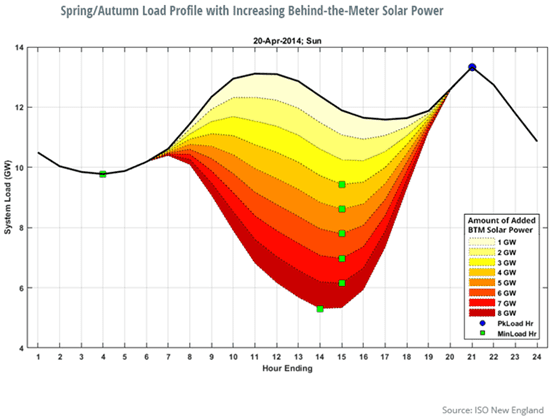A regional first: New Englanders used less grid electricity midday than while they were sleeping on April 21
 Solar power also pushes past 2,300 megawatts (MW) for first time
Solar power also pushes past 2,300 megawatts (MW) for first time
On Saturday, April 21, 2018, the right combination of sunshine and mild weather led to light consumer demand on the high-voltage electric power system, coupled with record-high output from the more than 130,000 solar power installations in the region. The result was that midday grid demand dipped below overnight demand for the first time ever in New England.
Only a tiny fraction of the region’s 2,400 MW (nameplate) of solar power is sold in the region’s wholesale electricity marketplace. Instead, almost all regional solar power is “distributed”—generated locally or installed directly on site at retail customers’ homes or businesses. New Englanders using distributed solar power use commensurately less electricity from the regional power system. As the grid operator, ISO New England experiences distributed solar power as a reduction in grid demand, as illustrated below.

Not a surprise
ISO New England’s system operators will remember April 21 as a milestone for electricity demand in New England, with these dramatic midday dips expected to crop up more often as more solar comes on line. Mike Knowland, ISO Forecast and Scheduling Supervisor, notes, “We were expecting this to happen at some point as more behind-the-meter solar gets installed in New England and the weather conditions were just right. While this kind of dip in demand is new for New England, it’s a common occurrence in California.” (Read about California’s experience.)
While distributed solar power was reducing demand, the seven large solar farms that do sell their power in the regional wholesale electricity market were at near-100% production Saturday afternoon, helping to meet the demand that remained on the regional power system. At their height, they were producing about 93 MW of their roughly 100 MW of nameplate energy production capability. The actual output from solar power installations can vary widely depending on things like:
- How high—or low—the sun is in the sky (due to time of day or time of year)
- The amount of cloud cover and haze
- Temperature and humidity
- Wind speeds
- Rain and snowfall
Preparing for more solar
The ISO has been preparing for the addition of more solar and the challenges that can come with the periods of very low consumer demand that lots of BTM solar power can lead to. Large, unexpected dips in demand can leave excess energy on the system, potentially causing dangerously high system voltages and frequencies and unscheduled flows of power into neighboring regions. In response, the ISO may have to issue emergency requests for power resources on the high-voltage system to reduce output or shut down (see FAQs: Minimum Generation Emergency). Shutting down generators when demand is dropping can lead to a secondary problem, though, because some resources can take many hours to start up again, leaving the ISO with fewer options for meeting rising demand later in the day as the sun goes down and demand starts to rise again. Due to jurisdictional and technological limitations, the ISO can’t instruct BTM solar installations to change their output.
With over 5,800 MW of BTM solar power expected in New England by 2027, the ISO anticipates more occasions when demand may dip extremely low, particularly during the spring and fall, as illustrated below. Demand is typically low already during those seasons, and conditions are ripe for high solar output. The graph also demonstrates how the region will increasingly need power resources that are able to quickly ramp up their output to bridge the steepening slope between minimum and peak load hours. (Learn more in Solar Power in New England: Concentration and Impact.)

Building a better day-ahead solar forecast
To be able to more accurately anticipate solar output, the ISO is working with industry experts to build a day-ahead forecast of distributed solar generation that can be integrated into our existing load forecast models, for an improved forecast of system load. Additionally, negative pricing should help minimize times where there’s too much energy on the system, while 2017’s improved real-time fast-start pricing will help incentivize power resources that can respond quickly to ISO dispatch instructions.
Wind records breaking, too
Solar output in New England is expected to keep breaking the regional record, but it’s not the only one. The region also recently broke its own record for wind power. Read more in “Earth Day 2018: Setting regional solar and wind power records in New England.”
- Categories
- Inside ISO New England
- Tags
- energy efficiency, forecast, generation, renewable resources, solar, system operations
